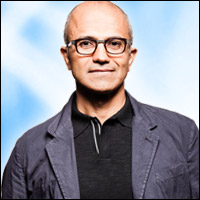
Microsoft will unify and streamline all its operating systems into one, and emphasize mobility and the cloud, CEO Satya Nadella told analysts in a call Tuesday after the company announced its earnings.
In a nod to the growing bring-your-own-device trend, the company’s devices and applications also will merge life and work.
Microsoft will “consolidate overlapping efforts,” Nadella said. “This means one operating system that covers all screen sizes and consolidated dual use productivity services that cross life and work.”
The company “will streamline the next version of Windows from three operating systems into one single converged operating system for screens of all sizes.”
What Nadella Wants to Do
Multiple Microsoft applications will be on every home screen. “This is why we brought Office to the iPad,” Nadella said.
“I think the project to code the major Microsoft applications for Android is under way,” said Ezra Gottheil, principal analyst for the computing practice at Technology Business Research.
“Why would you develop for iOS and not for Android?” Gottheil asked.
XMS versions of formats have “tamed, or at least rendered less awful” format compatibility issues, he told TechNewsWorld.
Thumbs Up for Nadella
“He’s saying the right things — breaking down the silos, focusing on the user, backing out of the dead end that was ‘devices,'” Gottheil remarked.
The emphasis on productivity instead of consumer and commercial, and the way “platform” comes to mean more than “operating system,” are plus points to Gottheil.
“Office, for instance, is a platform that runs on multiple operating systems,” he noted.
Nadella is “pointing — even leading — in the right direction,” Gottheil said. “From what I know of Microsoft people, I think they like the direction. But it remains to be seen whether they can change the institution to allow them to follow.”
Nadella still has to transform the culture, he cautioned.
To Our Children’s Children’s Children
This new strategy “anticipates the world of tomorrow,” Rob Enderle, principal analyst at the Enderle Group, told TechNewsWorld.
“As we go forward, mobile platforms will gain more capability, and much more emphasis will be placed on the cloud,” he pointed out. “In the developed world, we’re moving to a model that’s more like a cable operator and less like the PC world of the 90s.”
With that focus, “it’s much more possible to create a single OS,” Enderle said. Most applications will run off the cloud, not the client, which will be a thin, light client. High-end applications may constitute a superset on the cloud that is accessed as a service — again, with a thin client.
“We’ll probably be there in 10 years. A lot can happen in 10 years, but we’ll get there,” Enderle predicted.
“It feels like this is the right direction, but we need to watch and see how Microsoft enterprise customers respond,” said Wes Miller, an analyst at Directions on Microsoft. Many of them are excited about the cloud, but “the significant security, privacy and compliance concerns are keeping many away for the time being.”
There’s another concern, which has to do with the efficiency, or lack thereof, of manipulating large files on the cloud.
“The cloud-based Excel is very helpful in letting you access your spreadsheets wherever you are, but I wouldn’t want to put one of our 10-MB monster models into the Excel Web application,” Gottheil said.
What Must Be Done
Microsoft is “a large percentage of the way” toward developing a single OS, Miller told TechNewsWorld. Windows Phone, Windows RT and Windows 8.1, as well as Windows Server 2012 R2, all share code and the kernel.
The biggest gaps across the Windows family are the presence of the legacy desktop on RT and its absence on Windows Phone; the lack of a version of Office that can run in Windows RT without requiring the legacy desktop; and an application model that is not 100 percent aligned across Windows platforms — “but that’s now much, much closer,” Miller remarked.
Microsoft “has long been working to get shared code running in their applications across platforms,” he pointed out, “beginning with Bing but moving into OneNote and beyond.”






















































Social Media
See all Social Media